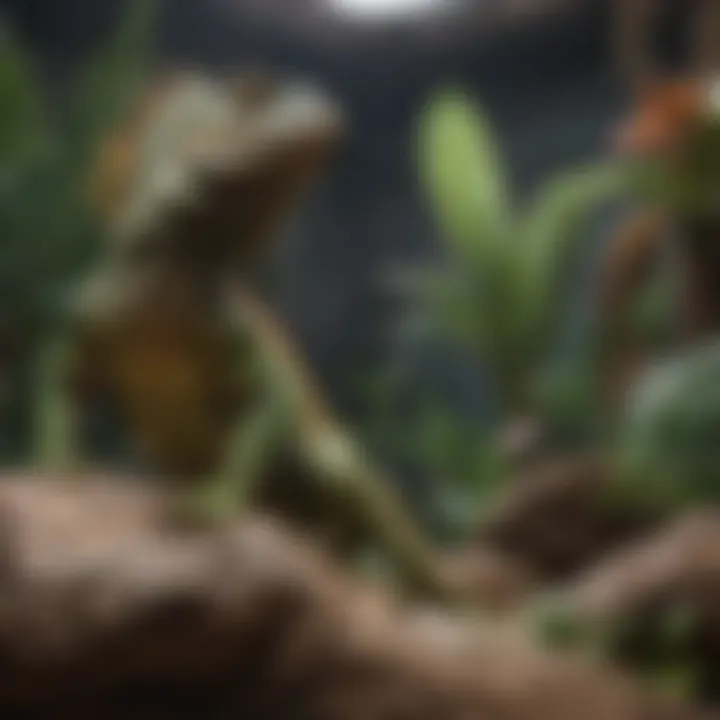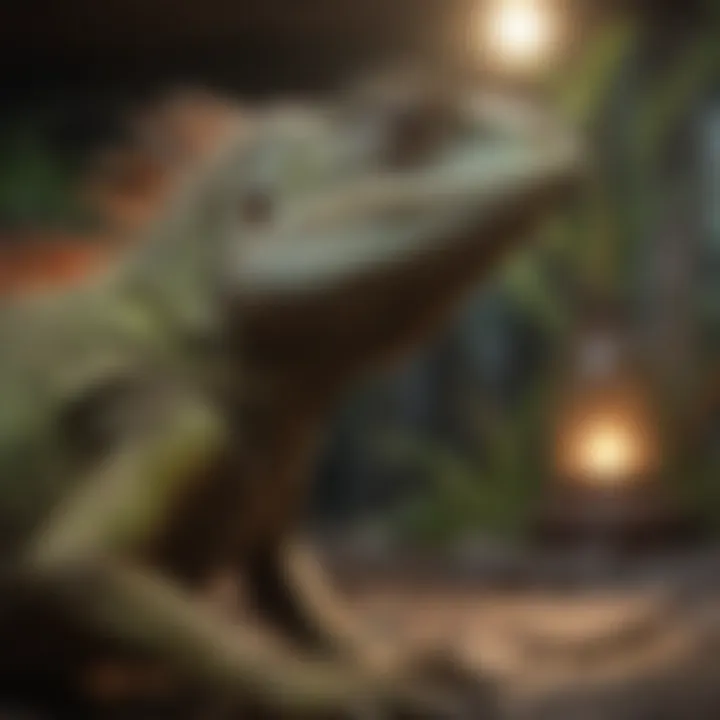Creating the Perfect Habitat for Your Iguana


Intro
Creating the right habitat for iguanas is crucial to their well-being. Designing a space that accommodates their unique needs is not a simple task. A spacious, enriching environment allows iguanas to thrive and exhibit natural behaviors. In this article, we will cover several aspects that contribute to an optimal iguana cage, focusing on area, materials, maintenance, and dietary considerations.
Care Tips
Daily Care Routines
Iguanas require consistent daily care. Start by checking their environment for temperature and humidity. Ideal temperatures during the day range from 85°F to 90°F, with a basking area up to 95°F. Humidity levels should range from 60% to 80%. It's also vital to observe your iguana's behavior to detect any signs of discomfort or stress.
Cage Setup and Maintenance
Creating an ideal cage begins with ample space. A minimum of 4 by 8 feet of floor area is recommended for larger individuals. Materials like glass and sturdy mesh are common choices, providing visibility and ventilation respectively. Ensure there are climbing structures as iguanas are natural climbers. Regularly check for wear and change any deteriorating parts to enhance safety.
Hygiene and Cleaning Practices
Maintaining hygiene within the cage is vital for health. Waste should be removed daily to prevent bacterial growth. A thorough cleaning with a mild detergent should be done at least once a week. Pay attention to surfaces, hiding spots, and water bowls, replacing and disinfecting them as needed.
Seasonal Care Adjustments
As seasons change, adjustments may be necessary. In winter, it's crucial to monitor heating closely, since iguanas are cold-blooded. Maintain adequate temperatures and humidity, as extreme changes can stress or harm your iguana. Spring or summer might require additional outdoor time for sunlight and fresh air, as long as the environment is secure.
Nutrition Guides
Essential Diet Components
Iguanas are herbivores, requiring a diet consisting mainly of leafy greens. Feed them a mixture of collard greens, dandelion greens, and kale. Other vegetable additions can include bell peppers and squash. Additionally, fruits should only be offered in moderation due to sugar content.
Safe and Toxic Foods
Certain foods can harm iguanas. Avoid feeding avocado, onions, and rhubarb, which are toxic. Always double-check fruits and vegetables before introducing them to their diet to prevent unwanted illness.
Supplements and Treats
Vitamins and minerals can supplement their diet, especially calcium. Look for calcium powders that lack phosphorous. Typically, a light dusting over their food a few times a week can assist in maintaining healthy bones.
Feeding Strategies for Different Species
Depending on the iguana species you have, dietary needs might differ slightly. Green iguanas have specific preferences; for example, they'll thrive on higher levels of calcium from specific leafy greens compared to other types. Understanding their species is critical when selecting a feeding strategy.
Wellness and Health
Routine Health Checkups
Regular health assessments help monitor your iguana's condition. Visiting a reptile veterinarian at least once a year is advisable. These check-ups should include weight monitoring and general body assessments.
Identifying Symptoms of Illness
Early identification of illness is key. Monitor for signs of lethargy, poor appetite, or swollen body parts. If any abnormalities are noted, a vet's consultation is recommended immediately.
Preventative Care and Vaccinations
While iguanas are relatively hardy, vaccinations may be a consideration. Consult your vet for necessary preventative care based on your iguana's health history and environment.
Mental and Emotional Well-being
An iguana's mental state is often overlooked, yet it is equally significant. Provide them areas to hide, stimulate them with climbing structures, and rotate their items regularly to engage their curiosity.
Enriching Activities
Toys and Playtime Ideas
When your iguana is out, ensure there are safe toys available. Introducing climbing branches and logs can encourage exercise and exploration.
Training and Tricks
Training iguanas can take time but offers rewarding interaction. Positive reinforcement through treats can develop a bond. Simple routines may include coming when called or navigating gentle courses.
Outdoor Activities and Interaction
If safe, outdoor play can offer great enrichment. Fresh air and Sonne exposure are beneficial. Always supervise extensively in unfamiliar spaces.


DIY Projects for Mental Stimulation
Create simple engaging objects from non-toxic materials. Cardboard structures or simple mazes can stimulate your pet cognitively, contributing to their emotional health.
Iguanas thrive in environments that allow them to exhibit natural behaviors. Proper setup and care should consider their physical and mental wellness equally.
Prolusion to Iguanas and Their Habitat Needs
Creating a well-designed environment for iguanas is crucial to their health and happiness. Understanding iguanas and their habitat needs allows us to offer them an enriched life. This is paramount to their behavior, growth, and overall well-being.
Understanding Iguana Behavior
Iguanas exhibit distinct behavior patterns that directly inform their habitat requirements. As naturally arborial creatures, they enjoy climbing and exploring their surroundings. In essence, they also express nesting and territorial behaviors. Ignoring these traits can lead to stress, aggression, or health problems in captive iguanas.
Proper observation and understanding of these behaviors can lead to design enhancements in their habitat. Adequate vertical space and hiding spots can give a sense of security. Moreover, knowing their social context contributes to how we set up group dwellings. Recognizing behaviors is not only beneficial for their well-being but also for owners aspiring to establish a better life for their pets.
Importance of Space in Captivity
Space is perhaps one of the most critical considerations when setting up an iguana's living area. Larger cages provide sufficient room for exercise and exploration, promoting healthier body weight and mental stimulation. Short on room? Your iguana may become frustrated and exhibit stress. Mental and physical health is connected strongly to habitat size.
For instance, incidents of inactivity can lead to obesity and, consequently, serious health concerns. Insufficient space can affect their demeanor, causing signs of irritability. Conversely, an expansive, thoughtfully designed cage encourages an iguana to take charge and explore.
To summarize, when considering iguana habitat design, take into account their specific behavior patterns. Foster psychological well-being by providing ample space and environmental enrichment. A proper understanding of both behavior and space will not only support comfortable living but will also enhance the human-animal bond.
"A proper environment can enable iguanas to exhibit their natural behaviors, promoting happier and healthier lifestyles."
Choosing the Right Size for a Big Iguana Cage
Selecting an appropriate size for an iguana cage is fundamental for the well-being of iguanas in captivity. Unlike many common pets, iguanas are inherently large and active reptiles. This necessitates ample space for movement, exercise, and natural behaviors. A poorly sized habitat can lead to stress, hindered growth, and even health complications. Thus, understanding the right size for your iguana habitat aims to promote a fulfilling and healthy life for these fascinating creatures.
Ideal Dimensions for Iguanas
The ideal cage dimensions can depend on the age, size, and species of the iguana. Generally, a good rule of thumb for the minimum length is twice the iguana's length from tail to snout. For smaller iguanas, like the green iguana, a cage that is at least 6 feet long by 3 feet deep and 4 feet high is suggested.
However, as the iguana grows, its cage should expand proportionally. Adult iguanas require even larger spaces, often nearing 10 feet in length. The required floor space is essential not just for basic movement but also for social interactions, territorial behavior, and stress reduction.
Regular measurement and adjustment of cage sizes can aid in ensuring a healthy living environment for your iguana. Here are some critical dimensions to consider:
- Length: A minimum of 6-10 feet.
- Height: At least 4-6 feet to allow for climbing space.
- Depth: A minimum of 3 feet.
Vertical Space Considerations
Iguanas are by nature arboreal, preferring to climb and perch in the wild. Therefore, vertical space in captivity holds immense significance. A big iguana cage must not only be wide and long but also tall to replicate the instinctive climbing habits of iguanas.
Th ability to ascend provides iguanas with opportunities to exercise, stretch and establish territory. Vertical space allows for the installation of branches, ledges, and man-made climbing structures. These elements encourage physical activity, directly benefitting the iguana's health.
Incorporating multiple levels and climbing surfaces can also help to prevent stress and discourage behavioral issues. For example, simple wooden shelves or safe, sturdy branches can serve as perches, mimicking their natural living environment. Moreover, having climbing materials allows iguanas to escape perceived threats and provides them potential hiding areas.
To maximize vertical space effectively:
- Install shelves or branches.
- Maintain a variety of climbing angles.
- Ensure stability to prevent falls.
Including vertical diversity within the cage layout aligns closely with the need for an optimized iguana habitat. Careful planning of both horizontal and vertical space is crucial to create a truly accommodating living environment.
Materials for Constructing an Iguana Cage
Materials for constructing an iguana cage play a crucial role in ensuring the health and well-being of these reptiles. Choosing the right materials impacts durability, safety, and overall habitat quality. An iguana's health is directly correlated to its environment, making it essential that the cage construction meets specific functional and safety criteria. This ensures that the iguanas can live comfortably while also making maintenance manageable for the owner.
Durability of Cage Materials
The durability of cage materials is imperative for the longevity and reliability of an iguana enclosure. Iguanas naturally tend to express their active behaviors through climbing and exploring. Therefore, selecting resilient materials like glass, metal mesh, polycarbonate, or sturdy wood is important. These materials not only withstand physical interactions but also resist eventual wear and tear.
In construction, focus on materials that do not easily warp or break. For example, glass aquariums could provide solid, leak-proof enclosures. However, ensure proper insulation and ventilation to avoid hazardous conditions. A well-constructed cage should endure daily wear without requiring frequent replacements or repairs.
Ensure any materials you choose feel substantial enough to withstand your iguana’s activities. A sturdy structure leads to fewer health risks for the animal and easier maintenance for you.
Safety Considerations for Iguanas
Safety cannot be overstated when it comes to building an iguana cage. First and foremost, avoid toxic materials that can harm these reptiles. Certain paints and outdated plastics can emit harmful chemicals. Always opt for non-toxic or untreated products.
Moreover, consider other specific factors that enhance safety in the environment:


- Secure Enclosure: Ensure the cage construction prevents escape as iguanas are skilled at finding their way out. Latches and locks should be firm and escape-proof.
- Smooth Edges: Sharp corners or exposed wires can cause injuries. Opt for rounded edges and cover any rough parts to maintain a safe environment.
- Proper Ventilation: Ensure the cage allows for air circulation, so your iguana can breathe comfortably and the humidity remains at advisable levels. Encouraging good airflow reduces the risk of respiratory troubles.
By emphasizing durability and safety, the construction of an iguana cage will set strong foundations for an accommodating and enriching habitat.
Cage Layout and Habitat Enrichment
Creating a suitable cage layout for an iguana is cructial for their overall well-being. An enriched habitat enhances the quality of life for iguanas by meeting their specific needs and allowing them to engage in natural behaviors. The importance of proper cage design and enrichment cannot be underestimated. Elements like climbing opportunities, hiding spots, and the right plant selection contribute greatly to their physical and mental health.
Creating Vertical Climbing Opportunities
Iguanas are naturally inclined to climb. They are arboreal by nature, seeking high ground in the wild for both safety and exploration. When setting up a cage, it's essential to incorporate vertical climbing structures to mimic their native environment. Using branches, platforms, or specially designed climbing walls will create adynamic habitat essential for your iguana's health.
These climbing features offer several benefits:
- Exercise: Climbing helps maintain their muscle tone and physical conditioning.
- Exploration: Encouraging natural exploratory behavior reduces stress and boredom.
- Safety: Providing elevated resting areas allows them to escape potential threats, real or perceived.
Consider using a mix of wooden branches and synthetic materials. Ensure all items are safe, non-toxic, and properly secured to avoid accidents. Height should vary to promote engagement with different levels of the layout.
Incorporating Hiding Spots
In addition to vertical dimensions, iguanas need areas to hide. These spaces ensure they feel secure and can relax away from open sight lines, which sets a comfortable foundation in this habitat. Hideouts can be made from various materials and can take the form of:
- Caves: A small cave made of ceramic or wood can serve as an excellent refuge.
- Dense Foliage: Plush plants provide both organic hideaways and natural aesthetics in the cage.
- Shelves or Ledges: Items that create recessed areas help maintain their edge between hiding and exposure.
Integrating hiding spots not only allows your iguana to mitigate anxiety but encourages exploration and behavioral richness within the enclosure.
Choosing Suitable Plants and Decor
When selecting plants, prioritize those that are safe for iguanas. Aesthetic choices not only enhance the habitat's appearance but also create microenvironments that intrigue your iguana. Suitable plants can provide coverage while also facilitating climbing. Some considerations include:
- Pothos: An easy choice that thrives in various lighting and adds shade.
- Spider Plant: It is safe and ideal for climbing and aesthetics.
- Bamboo: Vertical growth suited for climbing while providing slight barricade areas. Additionally, decorations should encourage exploration:
- Rock formations: Provide surfaces for basking and climbing while diversifying the terrain.
- Substrate: Natural substrates such as coconut coir can mimic the forest floor, inviting exploration while maintaining environment hygiene.
In summary, a thoughtfully arranged cage layout serves as the cornerstone of iguana habitat. Providing opportunities for climbing, hiding spots, and the use of plants will fully support the physical and emotional aspects necessary for their development. A quality environment promotes balanced and healthy lives.
Keywords like cage layout, habitat enrichment, climbing opportunities, and safe plants contribute to optimizing the environment for iguanas.
Environmental Control: Temperature and Humidity
Creating a suitable living environment for an iguana requires careful attentions to temperatures and humidity levels. A small miscalculation in these elements can lead to severe health risks for iguanas, who are highly sensitive to their surroundings. Ignoring these factors could have negative impacts on their overall well-being and longevity.
Maintaining Optimal Temperature Ranges
Iguanas are ectotherms, meaning they depend on their environment to regulate their body temperatures. Therefore, it is necessary to provide a temperature gradient within their cage: a warm basking area and cooler retreat spaces. Generally, a basking spot should reach about 95°F to 100°F (35°C to 38°C). The rest of the cage should maintain a temperature that ranges around 80°F to 85°F (27°C to 29°C).
Achieving these temperatures can be accomplished by using heat lamps or ceramic heat emitters angled appropriately to ensure iguanas can bask comfortably. Additionally, monitoring the temperatures using reliable thermometers is key. It's necessary to ensure these measures are maintained consistently. If these conditions are maintained correctly, iguanas can digest food properly and even engage in natural behaviors, contributing to their mental and physical health.
Humidity Levels and Water Sources
Along with temperature, humidity is a vital aspect of iguana care. Iguanas thrive in humidity levels between 60% and 80%. Inadequate humidity can lead to skin shedding issues and respiratory complications. To boost the humidity levels, consider using misting systems or providing water bowls that facilitate hydration.
Consider creating a balanced approach by incorporating live plants. These plants, aside from enhancing the cage aesthetic, can release moisture into the air absorbed by the iguanas. Regularly monitoring humidity levels using hygrometers is essential here. Providing multiple water sources within coverage areas can also assist in maintaining the requisite humidity range.
Remember, a consistent environment helps reduce stress and helps iguanas adapt well in captivity.
Iguanas need both temperature and humidity to be in balance. By carefully monitoring these elements and adjusting to meet the iguanas requirements, you are not only ensuring their immediate comfort but also fostering long-term health. This clear-cut attention leads to robust well-being for these fascinating creatures.
Dietary Considerations for Iguanas
Understanding the dietary needs of iguanas is crucial for their overall health and well-being. This section focuses on the different components that play a vital role in an iguana's diet. Providing a balanced diet ensures that iguanas get the nutrients they need to thrive. Not meeting their nutritional requirements can lead to various health issues.
Understanding Nutritional Needs
Iguanas are primarily herbivorous. This means their diet should consist mainly of leafy greens, vegetables, and some fruits. They require a significant amount of calcium, fiber, and a proper balance of proteins. It is essential to understand how to satisfy their needs effectively. Developing a deep knowledge of their specific nutritional requirements will assist in forming a comprehensive diet plan.
Calcium: The ratio of calcium to phosphorus should be balanced. Lack of calcium can lead to metabolic bone disease, which is detrimental to your iguana’s health.
Fiber: A high-fiber diet prevents digestive problems. Leafy greens are an excellent source of fiber. Ensuring proper digestion supports maximum nutrient absorption.
Proteins: They require very little protein compared to mammals, usually about 5% of their diet. Most we should avoid animal protein altogether.
Recommended Food Sources


Vegetables
Vegetables are fundamental in an iguana's diet. They provide essential vitamins and minerals. Leafy greens such as collard greens, mustard greens, and dandelion greens are especially favored. These greens are rich in calcium and facilitate proper weight management through digestion.
When thinking about vegetables, variety is key. Including different colors and textures can make feeding more fulfilling for an iguana. However, it's crucial to avoid starchy vegetables like potatoes. These can elevate the sugar levels in their blood and lead to health issues.
Prevent spoilage by removing uneaten fresh vegetables after a few hours in cage, as fresh greens can degrade quickly and turn toxic over time.
Fruits
Fruits can be a tasty treat for iguanas but should only make up a small fraction of the overall diet due to their high sugar content. They can be offered sparingly, but limit the intake to keep health risks at bay. Fruits like mango, papaya, and figs provide vitamins but should be given in moderation. Similarly, most fruits lack the necessary fiber, so overindulgence could result in stomach upset.
Consider this when incorporating fruits: freshness is important. Most fruits should be sliced and used promptly to maintain maximum nutrient value. Inspect fruit for mold before serving.
Supplements
Supplements can enhance an iguana's nutritional profile. A well-rounded diet sometimes lacks certain micronutrients. Calcium supplements, either in powder or liquid form, can provide supplemental handling for specific deficiency.
Don't forget about Vitamin D3 too. This vitamin helps absorb calcium effectively. Exposing iguanas to UVB light is another method to ensure they absorb nutrients optimally father than relying solely on vitamin composition of foods or supplements. It is advisable to consult with a veterinarian about specific supplementation plans.
Maintenance of the Big Iguana Cage
Maintaining a big iguana cage is a crucial element in ensuring the health and well-being of your pet. An iguana's environment makes up a large portion of its life experience. Without proper diligence in caring for their habitat, iguanas can face health challenges that impact their longevity and behavior. A well-maintained cage contributes directly to your iguana's physical health and comfort, reflecting on their overall quality of life. As iguanas grow and change, regular evaluation of their environment will help accommodate their evolving needs.
Cleaning and Hygiene Practices
Routine cleaning is a foundational aspect of maintaining a big iguana cage. Not only does it promote a hygienic space, but it also helps minimize the risk of infections and parasites. Here are some key practices:
- Daily Spot Cleaning: Remove any waste materials, uneaten food, or soiled substrate every day. This will help keep the habitat clean and reduce odors.
- Weekly Deep Clean: A thorough clean should involve disinfecting surfaces. Use a reptile-safe disinfectant to clean the cage interior, including branches, floors, and any accessories. Ensure rinse thoroughly to avoid any harmful residues.
- Substrate Maintenance: If using substrate like coconut fiber, it should be spot-cleaned and replaced regularly. The substrate can harbor bacteria or mold, which can be detrimental to health.
- Water Hygiene: Water bowls should be replaced and scrubbed daily. Stagnant water is a breeding ground for bacteria, so keep it fresh to promote hydration.
Implementing effective cleaning routines minimizes health risks primarily attributed to unsanitary conditions. It can also prevent stress among iguanas, who might feel discomfort in an untidy environment.
Monitoring Health and Behavior
Regular monitoring of your iguana’s health and behavior plays a critical role in effective cage maintenance. Being attentive to their needs helps detect potential issues early and ensures your iguana remains robust. Here’s how to consistently monitor:
- Behavioral Observations: Watch for changes in activity levels. A lethargic iguana may indicate health problems, while unusually aggressive behavior might suggest stress due to habitat issues.
- Physical Health Checks: Routine examination of your iguana for signs of shedding difficulties, swelling, or unusual growths can act as an early warning system. Ensure the nails are not overgrown; they may require trimming considerably or cause injury.
- Food Intake: Pay close attention to your iguana's diet. Changes in appetite can be a referral sign of underlying problems. Ensure they thrive on a balanced diet with enough leafy greens, safe fruits, and proper supplements.
- Environment Adjustments: If there are occurrences of stress, investigate your cage setup. Environmental controls such as lighting, temperature, and humidity should align with iguana species requirements. Regularly assess these factors.
Vigilance is vital to maintaining iguana health. Small deficiencies or adjustments can lead to more severe health issues if neglected.
In summary, maintenance of a big iguana cage goes beyond basic cleanliness. It encompasses regular monitoring of your iguana’s health and environment. By integrating appropriate practices for cleaning and observation, you promote a more vibrant living space and a better quality of life for your iguana.
Common Mistakes to Avoid When Setting Up a Cage
When creating an environment for your iguana, understanding common mistakes is vital. Proper setup contributes to wellbeing and health. If overlooked, these errors can lead to serious issues for the iguana. Recognizing the most typical challenges is an essential first step.
"An iguana’s habitat is its lifeline; ensure it is designed with care."
Insufficient Space for Growth
Iguanas can grow large; their cages must accommodate this trajectory. A common error among iguana caretakers is underestimating the necessary space. Observations show that iguanas require more area as they age. The wrong dimensions might obstruct their development and natural behavior.
Adult iguanas, depending on species, often need a cage that is at least 6 feet long, 4 feet wide, and 4 feet high. This will not only provide room for movement but also opportunities for climbing. The failure to provide adequate space can lead to stress and inhibit their active nature.
Ignoring Temperature and Humidity Needs
Another frequent oversight relates to the control of temperature and humidity. Iguanas are ectothermic animals. Therefore, maintaining the right ambient conditions is paramount. If the habitat gets too cold or damp, or too dry and hot, the reptile could experience health incidences.
Optimal temperature varies depending on the time of day. Giant iguanas thrive between 75°F and 85°F during the day, and they may benefit from a basking area that reaches up to 95°F. Understanding these climatic contingencies enhances care for iguanas.
Humidity levels are equally crucial. A humidity range of 60% to 75% is ideal. Regular misticking and proper water sources help maintain that balance. Neglecting either temperature or humidity knowingly places the iguana at risk for respiratory problems or shedding errors.
Being aware of and avoiding these mistakes plays a critical role in improving an iguana’s living conditions. This knowledge fosters a healthy, thriving pet.
Culmination: Future Considerations
Creating an environment suitable for iguanas takes time and attention to detail. As we conclude this article, it is essential to reflect on future considerations that ensure a thriving habitat.
Investing in a quality cage design stands at the forefront. The structure must harmonize with the needs of iguanas, focusing not only on their immediate comfort but also allowing room for growth and adaptation. A well-designed cage provides ample space, ventilation, and access points that reflect an iguana's natural behavior. For owners aiming for a successful long-term relationship with their reptiles, the initial decision on cage design dramatically influences overall well-being.
Continual learning in iguana care cannot be overstated. Seasoned iguana caretakers often emphasize that the journey doesn’t end upon setting up the cage. Staying updated with the latest information on iguana behavior, diet, and habitat management aids owners in providing optimal care. Communities like reddit.com and resources such as britannica.com can provide anecdotal insights and scientific information, making them invaluable tools for iguana enthusiasts.
Aside from investing in a snail and intentional cage design, future management requires reflection. Some important points to keep in mind include:
- Monitoring changes in weather or climate may help to adjust heating and humidity needs accordingly.
- Regular checks of cage materials or structural integrity prevent potential hazards that could affect the health of the iguana.
- Engaging with other iguana owners and caretakers helps to exchange strategies or insights that can be beneficial to new developments in iguana care.
The best care practices come not just from research, but from shared experiences and solutions; engage others in the iguana community for ongoing support.















